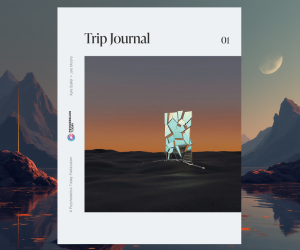By Jessika Lagarde
Sacred psychedelic plant medicines are increasingly entering the Western mainstream, but is it cultural appropriation?
From the medicinal and ceremonial use of mescaline-containing plants by the Indigenous peoples of Mexico thousands of years ago, to the brewing of ayahuasca by several Indigenous groups in the Amazon today, entheogens have been a part of the cultural heritage of these communities in ways that Western society is just starting to understand.
Because there are significant differences in the ways these plants have been used historically and the way Western society is integrating them, let’s take a brief look at both approaches.

Indigenous Uses of Sacred Plant Medicines and Traditions
Various Indigenous cultures have used medicinal plants with psychoactive properties for hundreds of years including the Mazatec and Huichol of Mexico, Native North Americans, tribes in Africa, and Indigenous groups in the Amazon. The uses of these plants vary from culture to culture, but have a few commonalities when it comes to their healing purposes. For most, there is a general belief in their sacredness and spiritual properties.
“Plants, in general, have been used for ceremony, food, and utilitarian purposes. Sacred plant medicines were always used in ceremonies and never used for recreational purposes. Plants were placed on this earth to heal humanity as I understand it,” Belinda Eriacho, Native American Healer, tells Psychedelics Today. “In my own experiences, these sacred plant medicines have helped me to heal intergenerational trauma, to find peace with deceased loved ones, and to look at my own life and improve many areas of [it].”
When it comes to ayahuasca, Indigenous peoples from Brazil, Peru, Bolivia, Colombia, and Ecuador have used the brew in their sacred rituals for many years. It served and continues to serve as a basis for the establishment of different spiritual traditions by these peoples. They hold the vine in high regard and believe it can facilitate the perception of the complexity of the natural world and human creation.
Similarly, the consumption of peyote in sacred rituals allowed the Huicholes and the Tarahumaras of Mexico to come into contact with divine beings or ancestors and to cure various diseases. To this day, peyote has also been adopted by several Native American peoples. They see peyote as a gift from the creator, and a direct communication channel with the “Great Spirit”.
These cultures have preserved rituals and sacred medicines but have also gone through extreme hardships in order to do so. Many Indigenous spiritual practices in Mexico were severely persecuted and banned during the Spanish Inquisition, and hundreds of thousands of natives were brutally murdered. Many other Indigenous communities in the Americas faced the same barbarities during colonization, having their codices destroyed and much of their ceremonial knowledge lost.
Western Uses of Plant Medicines
In the Western world, the use of psychedelic plant medicine can also be traced for thousands of years. A few examples are The Eleusinian Mysteries, the most famous of the secret religious rites of ancient Greece that involved ceremonies with psychoactive plants. Furthermore, Indigenous peoples of Siberia and the Sámi people of Northern Europe used Amanita Muscaria mushrooms in their sacred traditions.
Many medicinal plants have found their way into numerous products that the pharmaceutical industry sells today to treat a variety of diseases and health conditions, from aspirin derived from willow tree bark, to the current growing interest in entheogens for therapy and the possibility to revolutionize global mental health.
Scientists have been carrying out research for decades on psychedelic plants for their chemical properties and pharmaceutical potential. In this model of Western medicine, science seeks to understand these substances simply as chemical compounds detached from their ethnobotanical origin.
Adapting the uses of sacred psychedelic plants to Western medicine brings the advantage of making them accessible to people who can benefit tremendously from their properties on a global scale. In recent years, research into psychedelics has demonstrated their potential to address disorders that have proved difficult to treat including depression, anxiety, chemical dependency, and post-traumatic stress disorders.
But in reality, there is a suspicion that dominating the market is more important than addressing the mental health crisis. For instance, we are currently witnessing a debate on whether it’s ethical for companies such as COMPASS Pathways to try and monopolize the psychedelic industry with their patent strategy.

Additionally, in the past few years, the New Age spirituality movement has merged with positive psychology and the wellness industry, bringing many to seek healing, transcendental experiences, and self-improvement through entheogens. For many, these plants are the catalyst of positive life changes and are also revered with respect. However, there is concern that some are engaging in ceremonies so often that “spiritual bypassing” is now a recurring theme in psychedelic community discussions.
“I find it interesting how often I hear stories of people doing ceremony [using sacred plant medicines] every weekend. In many indigenous cultures, you were blessed to have one ceremony in your lifetime,” says Eriacho. “I would suggest that if individuals are finding that they need to use these plant medicines every weekend then (1) they are not taking the time to fully integrate into the experiences shown to them, and (2) these plant medicine(s) are not working for them.”
This high demand and constant search are not without negative consequences. Issues related to cultural appropriation, sustainability, and the commercialization of spirituality are often ignored by Westerners while engaging in such frequent ceremonies and spiritual tourism when they should be taken into greater consideration.
What Is Cultural Appropriation?
To understand the meaning of “cultural appropriation”, we need to understand the meaning of “appropriation” and ”culture” on an individual basis. We can define culture as the set of practices, symbols, and values that a specific group shares. For example, tattoos are an important symbol for many Indigenous cultures, as they are an essential part of the historical constitution of the groups to which they belong.
On the other hand, appropriation is the act of taking for oneself a certain element without the owner’s consent. So cultural appropriation would be the action of adopting elements of a culture to which you don’t belong without consent. An important detail to remember is this becomes problematic when it involves a power relationship. For example, it’s cultural appropriation when a culture which has historically been suppressed and marginalized has its elements stolen and its meanings erased by another culture that has dominated it.
Cultural appropriation contributes to the maintenance of structural racism in our society and the continuity of different stereotypes about cultures. But we must not forget that individuals appropriating a culture are just symptoms of a much larger problem. A capitalist system that aims for profit and uses extractivism (the exploitation of natural resources on a massive scale generating significant economic profits for a powerful few) to transform a community’s culture into a product but does not value the people whose culture it belongs to, is the real problem that needs addressing.
In the context of medicinal psychedelic plants and fungi, cultural appropriation may manifest itself in different ways. An example was the bioprospecting (the practice of searching for botanical miracle cures) of psilocybin mushrooms out of their Oaxacan context at the end of the 1950s by R. Gordon Wasson. And more recently, cases of “neo shamans” offering ceremonies they label “authentic” without years of experience and a real understanding of the cultures to which these ceremonies belong, are also examples of cultural appropriation.
The Answer? Awareness, Balance and Respect
There is a growing tendency to commodify these substances without giving back to the communities who have held this knowledge for centuries at their own risk. For example, who is really benefiting from expensive retreats in the Amazon jungle? Additionally, the development of new treatments with synthetic derivatives of these substances will reach the market through pharmaceutical patents without properly recognizing traditional knowledge.
For Indigenous people throughout the world, the commercialization of their spirituality is just one of many daily challenges embedded in larger societal struggles. Western engagement with Indigenous spiritual traditions often contributes to a false romanticization of these communities’ situations; it can even feel like an erasure of the injustices that they have experienced in the past, and continue to experience to this day. Indigenous people have to fight daily for the preservation of their lands, their languages, and their cultures. In fact, many continue to be murdered for standing up for their rights. As psychedelic enthusiasts, we have the responsibility to bring awareness to these dynamics.
“While psychedelic plant medicines still have most of their potential still to be taped into for the benefit of society, contemporary psychedelic studies are at risk of replicating harmful colonial behavior with the territories and communities from which the plants originate,” writes anthropologist, Paloma David, in her forthcoming publication, “Decolonizing Psychedelic Studies: The Case of Ayahuasca”. “A decolonial approach is essential to the current renaissance as failing to recognize indigenous perspectives as equally valuable to the discussion in the appropriate use of these substances only contributes to deepening the colonial wound in which these plants are interwoven.”

Will psychedelics be reduced to high-class wellness, healthcare, or self-optimization products that are only accessible for those who can afford the steep price tag while the people that carried this traditional knowledge are excluded from the market? As we are about to enter the era of psychedelic capitalism, it’s important for us to remember that balance can be achieved if we acknowledge that respect is crucial for any relationship.
We need to look at what we are doing when it comes to sacred plant medicine, how we are doing it, and what impact our actions have on other communities around the world. There needs to be an effort to educate ourselves in order to comprehend Indigenous paradigms, and the effect of their loss of languages, land, culture, and knowledge. As we begin to better understand spiritual identity and sacred reciprocity, we can start making an effort to no longer let Indigenous peoples and their cultures be seen as resources to be harvested.
“Through my lens as a Native American woman, when we are ill or when we seek balance in our lives through ceremony, we often look to our plant relatives for healing,” says Eriacho “There is a ritual or practice of utilizing these sacred beings. Before the plant is harvested, we are mindful about how much will be needed, and then explain to the plant why it is needed and for whom. This is done out of respect for the plant in exchange for its life. We offer tobacco, cornmeal as an act of appreciation. This is referred to as sacred reciprocity. We need to be respectful and reverent of these sacred plant medicines.”
So how can we protect and develop traditional ceremonies in a way that is useful and respectful of Indigenous communities? And how can we prevent the so-called psychedelic renaissance from exclusively benefiting non-Indigenous Western entrepreneurs?
When I speak to Paloma David about how we can move forward in a respectful fashion, she says, “Firstly, by being culturally humble in actively listening to Indigenous voices who are authorities on the use of psychedelic plant medicines and actively including them in the conversation on the appropriate use of these substances.”
“By being aware of our own cultural biases. By understanding that people’s making-sense of an ayahuasca experience is highly dependent on their cultural background, religious beliefs (or the lack thereof), and personal psychology.” David continues, “And secondly, by avoiding the harmful reproduction of colonial dynamics of appropriation, epistemicide and exploitation in which the Amazon rainforest and Indigenous knowledges are interwoven.”
Reflecting on these ethical dilemmas can offer us models for understanding and solving this continuing harmful and extractive economy. Another solution might be pointing out paths for fair and reciprocal reparation agreements with Indigenous communities.
More importantly, considering these issues make us question the colonial and racialized Western mentality that contributes to the continued delegitimization of Indigenous communities and their knowledge so we all can at least start asking ourselves: What are the true costs of our healing?
About the Author

Jessika Lagarde is a Brazilian storyteller, Earth and climate activist, and Women On Psychedelics co-Founder. Women On Psychedelics is an educational platform that advocates for the end of the stigmatization around women’s mental health and substance use, and the normalization of the use of psychedelics for its therapeutic potential and healing capacities. Jessika’s environmental work and psychedelic path have made her more aware not only of the crisis of our planet but also of how human disconnection is a direct cause of it. All of her work is informed in taking action in a way that serves the Earth and our human collective, in hopes of mobilizing inner healing towards outer action.


